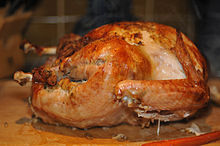Photo by M. Rehemtulla, CC BY 2.0 
According to author and food waste expert Jonathan Bloom, food waste is not just a moral issue, but also an environmental issue. “A tremendous amount of resources go into growing our food, processing, shipping, cooling and cooking it,” said Bloom. “Our food waste could represent as much as six percent of U.S. energy consumption.”
“Landfills are the second largest human-related source of methane. Food is the second largest component of landfills. In a sense, we’re aiding global warming when we throw food in the garbage,” explains Bloom.
There are solutions to this dilemma. Food rescue organizations, and practices that reduce food waste, are gathering support across the country. From a few friends picking up leftovers at a catered event, to a statewide ban on food waste (like the law recently passed in Massachusetts), eaters, businesses, and policymakers are preventing food loss and waste. Organizations and food programs in cities like San Francisco and New York are collecting leftovers and food past its “sell-by” dates from grocery stores and cafes to create meals that feed their communities, especially around the holidays.
Here’s how you can cut down on food waste while enjoying your holiday favorites.
- Open your refrigerator first. The U.S. Environmental Protection Agency (EPA) suggests taking inventory of your refrigerator and pantry to see what you have already before heading out to the store. We all have cans hiding in the back corner we forgot about. There’s no reason to buy more of what you already have.
- Plan your menu and know your numbers. According to the Natural Resources Defense Council, planning menus in advance can limit waste. A head count will help you increase or decrease recipe measurements to the correct proportions, making it easier to buy the correct amount of ingredients.
- “Sell by” and “best by” dates aren’t chiseled in stone. These dates are guidelines. Some products may still be good long after their expiration date. Bloomsuggests, “you should always trust your senses before that arbitrary date on the package. Look, smell, and if it comes to it, taste it before you throw it away.”
- Repurpose turkey giblets, stale bread, and other “waste.” Remember Grandma’s to-die-for gravy? Chances are she used turkey giblets to flavor the family favorite. The EPA suggests using parts of the bird that normally end up in the trash as a great way to pump up flavor while reducing waste in landfills. That mound of veggie tops and roots? Make homemade soup stock and freeze it for later.
- Portion control is key. Using smaller plates and Love Food Hate Waste’s portion calculator can help in making the right amount whether you are cooking for two or 20 people.
- Love your leftovers. Love Food Hate Waste provides recipes to creatively use leftovers. Using leftovers in another recipe following a holiday dinner makes meals easy. Cook once, eat twice.
- Donate to the hungry. Find your local food bank, and donate excess or unused food to those in need.
- Serve others. Eaters can help people, and our planet, by volunteering at places likeD.C. Central Kitchen and City Harvest. There are similar organizations that use donated food to cook for communities in need in cities across the U.S. Gather friends or family members to multiply your efforts and reduce more waste.
- Encourage policy makers to create and foster a food system that serves consumer health and the environment. Improving labeling policies and practices can decrease confusion for consumers, leading to a reduction in food waste. A recent report by Emily Broad Leib, Director of Harvard Food Law and Policy Clinic, states, “Congress, federal administrative agencies, state legislatures, and state agencies should work towards a system of date labeling that is more standardized, more easily understood by consumers, and less arbitrary.” Encourage policy makers to reduce food waste and improve food safety.
There are many more ways to make holiday traditions less wasteful and more delicious for everyone. Do you have a creative way to reduce holiday food waste? Email me at danielle@foodtank.com.







0 Comments